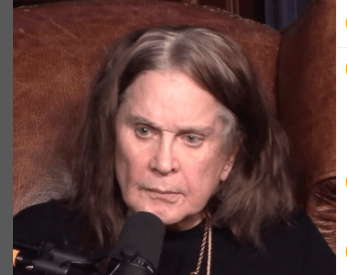Ozzy Osbourne’s remarkable enduring effect on music and popular culture is demonstrated by his $220 million fortune. Few artists have undergone this many reimaginings with such stable financial results. From his working-class beginnings in Birmingham to the turbulent pinnacle of rock, Osbourne’s career was characterized by risk-taking, resiliency, and reinvention.

Osbourne transformed into Black Sabbath’s raspy, eerie vocalist in the early 1970s, when the band’s powerful riffs and melancholy lyrics completely changed the sound of rock. Platinum-selling albums like Master of Reality and Paranoid established a foundation that was extraordinarily successful for decades. The foundation for a financial empire based on sound and cultural influence was established during these formative years.
Ozzy Osbourne – Personal and Professional Details
| Detail | Information |
|---|---|
| Full Name | John Michael “Ozzy” Osbourne |
| Date of Birth | December 3, 1948 |
| Date of Death | July 22, 2025 |
| Birthplace | Aston, Birmingham, England |
| Occupation | Singer, songwriter, actor, television personality |
| Active Years | 1967–2025 |
| Key Achievements | Co-founder of Black Sabbath, successful solo artist, creator of Ozzfest |
| Estimated Net Worth | Around $220 Million at the time of death |
| Notable Works | Paranoid, Blizzard of Ozz, Diary of a Madman |
| Reference | celebritynetworth.com |
Osbourne might have been forgotten after Black Sabbath abruptly fired him in 1979 for substance addiction. Rather, he began a solo career that was very advantageous to his financial situation. Blizzard of Ozz, his debut album, was a financial success because to hits like “Mr. Crowley” and “Crazy Train.” The triumph demonstrated his remarkable capacity to reinvent himself while captivating audiences, a talent that would become remarkably evident throughout his career.
Osbourne’s albums during the following 20 years solidified his solo success and guaranteed a consistent flow of royalties. His estate was able to sustain long-term earnings through publishing, streaming, and licensing thanks to timeless hits like “No More Tears” and “Mama, I’m Coming Home.” He established a surprisingly stable financial base by expanding his sources of revenue beyond live performances. This base remained extremely effective even as his touring slowed with age.
Osbourne’s endeavors went much beyond the stage. He founded Ozzfest, a traveling metal event that became a mainstay of contemporary rock culture, in 1996 with his wife Sharon. The event was more than just a series of concerts; it was a brand, an experience, and a source of revenue. Ozzfest developed into a very adaptable business that greatly increased Osbourne’s revenue while introducing heavy metal to innumerable fans through merchandise, ticket sales, and sponsorships.
He went from being a rock star to a pop culture phenomenon in the early 2000s when he made the move to television with MTV’s The Osbournes. The popularity of the reality program was remarkably comparable to how Elvis Presley’s broadcast concerts transformed celebrity culture. This surprisingly successful crossover introduced Osbourne into millions of homes and produced a sizable revenue through international brand agreements and syndication.
His financial empire had grown to include products, intellectual property rights, real estate, and music royalties by the late 2000s. However, the same qualities that made him successful also added difficulty. According to reports, his estate had two federal tax liens totaling more than $5 million and an unpaid tax obligation of around $8 million. Although concerning, these numbers are typical for high-net-worth estates with international holdings in the US and the UK, where inheritance and estate taxes can reduce value if not carefully managed.
Both his Buckinghamshire home in England and his Los Angeles mansion, which was shown in The Osbournes, were opulent yet expensive representations of his dual life, divided between two tax regimes and two cultures. When his health started to deteriorate, the logistical burden of overseeing such assets became very difficult. According to insiders, Osbourne worked with unexpected tenacity in his latter years because he wanted to “leave his family comfortable.” Considering his longtime reputation for disorder and unpredictable behavior, it was an especially poignant sentiment.
Osbourne continued to record and perform sometimes in spite of his deteriorating health. His ability to stay current was demonstrated through his partnerships with up-and-coming musicians, such as Post Malone, which helped his brand remain successful into the future. Following each public appearance or health update, media attention and streaming surges were secured by the persistent attraction with his demeanor, which was a blend of humor and threat.
Decades of music sales, royalties, touring earnings, real estate, and intellectual property are all included in the estimated $220 million valuation of his estate. However, analysts point out that a large portion of that worth is illiquid and linked to real estate and music collections that his heirs will need to manage carefully. However, his work’s continued popularity guarantees a consistent stream of posthumous income, similar to that of the estates of legendary figures like David Bowie or Freddie Mercury.
The financial fallout from his passing also highlights the intricacy of celebrity riches, which is sometimes disregarded. Sharon Osbourne must perform a careful balancing act due to her foreign possessions, outstanding tax bills, and residual royalties. According to insiders, she is still dedicated to upholding the integrity of the estate and is apparently looking for expert advice to restructure assets and pay off remaining debts. This procedure is anticipated to take years, but it will probably safeguard the family’s heritage.
